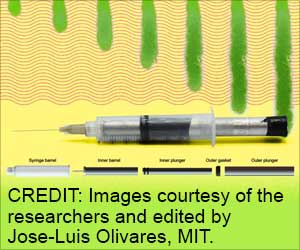Experience painless treatments with needle-free shock syringes, offering innovative, safe, and efficient drug delivery without the discomfort of traditional needles.

Drug Delivery System
Go to source), minimizing skin damage and infection risks. The team, from the Department of Aerospace Engineering at IIT Bombay, explained that, unlike syringes with needles, the shock syringe doesn’t rely on piercing the skin with a sharp tip. Instead, it uses high-energy pressure waves (shock waves) that can travel faster than the speed of sound to pierce the skin. These waves, when generated, compress the surrounding medium (such as air or liquid) through which they travel, the team said in their study published in the Journal of Biomedical Materials & Devices.
‘Needle #phobia keeping you from essential healthcare? New #needle_free shock syringes that could revolutionize treatments for those who fear needles. #IIT’





Minimizing Tissue Damage and Ensuring Precise Drug Delivery
"The shock syringe is designed to deliver the medication rapidly. However, if a regular syringe is inserted too quickly or with excessive force, it can cause unnecessary trauma to the skin or underlying tissues," said lead author Priyanka Hankare, a research scholar at the varsity.To minimise tissue damage and ensure consistent and precise drug delivery, the pressure in the shock syringe is continuously monitored and "rigorous testing on tissue simulants (such as synthetic skin) helps to calibrate the force and speed of jet insertion, ensuring safety and comfort", Hankare said. In addition, the researchers optimised the nozzle design to have an opening of just 125 µm (roughly the width of a human hair).“This ensures it is fine enough to reduce pain during insertion but strong enough to handle the mechanical forces needed for quick deployment of microjet,” Hankare said.
To test how efficiently the shock syringe delivers the medication, the researchers conducted three different tests in which they injected three different types of drugs into the rats. They measured the drug levels in the blood and tissues to monitor drug distribution and absorption in the body using the high-performance liquid chromatography (HPLC) method.When an anaesthetic (Ketamine-Xylazine) was injected through the skin of the rats for the tests, the shock syringe achieved the same effect as needles. In both cases, the anaesthetic effect started three to five minutes after injection and lasted up to 20-30 minutes.
This proves the suitability of the shock syringe for drugs that require slow and sustained release. For viscous drug formulations, such as an antifungal (Terbinafine), the shock syringe outperformed regular needles. The rat skin samples showed that the shock syringe deposited more terbinafine deeper into the skin layers than needle delivery. When insulin was administered to diabetic rats, the researchers observed that the blood sugar levels were lowered effectively and maintained at the lower level for a longer time when using a shock syringe compared to needles.
Further, tissue analysis revealed that the shock syringe caused less damage to the rat’s skin than syringes. As shock syringes cause less inflammation, they allow the wound at the injection spot to heal much faster. The development of a shock syringe promises more than pain-free injections.
Advertisement
- Drug Delivery System - (https://www.sciencedirect.com/topics/nursing-and-health-professions/drug-delivery-system)
Source-IANS









